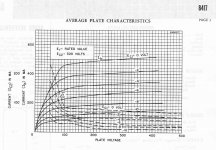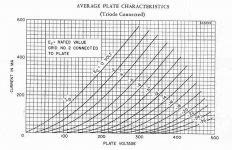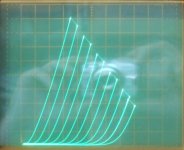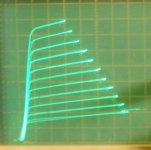1:-I would say these tubes were specially developed for Bogen so that a cheap amplifier could be made with a wimpy driver. The poor power supply regulation for the screen and bias voltages in the Bogen amp cause the distortion to go out of control at high power. 6%
2:-The low bias currents in the Bogen amp caused crossover distortion, and the bias adjustment range won't allow fixing that.
3:-Then the Bogen design had an outright biasing error issue in the 7247 stages that caused it to "pulse" at high power levels.
Any more complete nonsense to add here?
FYI The 8417 was really originally designed for a portable HF amplifier and/or sweep tube app, nothing whatsoever to do with Bogen, who are (still) just another OEM.
It make a very good transmitter valve as does the 807 which also has to have very careful g2 regulation.
If you like, it's like an 807 "on steroids, 4x the gain needing much less demanding drive requirements but with no top cap or UX base to mess with.
The 807 as we all know well makes an excellent amplifier valve, but with the proviso the G2 is regulated carefully and dissipation not exceeded.
From what I heard, the Quicksilver (8417) amp which is nigh on a clone of the Bogen, is highly regarded and very sought after.
I simply don't get any of the other things you are somehow saying (?based on hearsay?), especially once the input stage & driver and taken to a decent current condition.
+
Poor regulation?
What on earth are you on about?
This amp already has solid state rectification from the mid 60s.
My measurements suggest neither any weakness in the power transformer nor the 300v regulation line at all.
Perhaps you don't know, likely you are guessing or are just making it up as you go along?
Last edited:
I read the long AudioKarma thread, guess you didn't.
Here is the original Westinghouse 8417 registration.
High sensitivity audio tube and voltage regulator.
Seems to be the only "audio" tube Westinghouse ever designed, "nice" curves. Notice it came from the Industrial Division.
Here is the original Westinghouse 8417 registration.
High sensitivity audio tube and voltage regulator.
Seems to be the only "audio" tube Westinghouse ever designed, "nice" curves. Notice it came from the Industrial Division.
Attachments
Last edited:
One can tell the quality of the linearity of a pentode by looking at its triode curves.
Ones which have the g1 wires too close to the cathode (compared to grid wire spacing), in order to get more gm, develop a distinctive tilt-over in the triode curves.
Here are the 8417 triode mode curves. Then a common TV "Sweep" tube in triode mode. Its fairly clear the 8417 is not a frame grid. No wonder they are known for failing with such close grid-cathode spacing to get high gm.
8417 would not pass muster for a Sweep tube or an RF tube with kilovolts across pins 2 and 3. I'll bet most of the Bogens have had HV arcs into the filament winding on the power xfmr. Then there is the high screen current issue from non-aligned grids, causing distortion there too.
Ones which have the g1 wires too close to the cathode (compared to grid wire spacing), in order to get more gm, develop a distinctive tilt-over in the triode curves.
Here are the 8417 triode mode curves. Then a common TV "Sweep" tube in triode mode. Its fairly clear the 8417 is not a frame grid. No wonder they are known for failing with such close grid-cathode spacing to get high gm.
8417 would not pass muster for a Sweep tube or an RF tube with kilovolts across pins 2 and 3. I'll bet most of the Bogens have had HV arcs into the filament winding on the power xfmr. Then there is the high screen current issue from non-aligned grids, causing distortion there too.
Attachments
I'm not trying to pick on your Bogen restoration.
To be clear, I don't think much of ANY of the classical amplifiers out there at hyper inflated prices. McIntosh's Unity Coupled innovation, while clever, does NOT solve anything useful for audio (no, it does NOT fix crossover distortion one bit). The Citation II uses crummy "audio" tubes in UL...... Both DO however use local feedback from the OT primary to linearize the output tubes, while using reduced global feedback to fix the damping factor. That is the key design factor. And it can be taken further with -selected- "Sweep" tubes, some of which have better triode curves than a 300B, since they allow low primary Z OTs to be used.
Some classic amps just present a bigger hole in the ground than others.
To be clear, I don't think much of ANY of the classical amplifiers out there at hyper inflated prices. McIntosh's Unity Coupled innovation, while clever, does NOT solve anything useful for audio (no, it does NOT fix crossover distortion one bit). The Citation II uses crummy "audio" tubes in UL...... Both DO however use local feedback from the OT primary to linearize the output tubes, while using reduced global feedback to fix the damping factor. That is the key design factor. And it can be taken further with -selected- "Sweep" tubes, some of which have better triode curves than a 300B, since they allow low primary Z OTs to be used.
Some classic amps just present a bigger hole in the ground than others.
I read the long AudioKarma thread, guess you didn't.
Seems to be the only "audio" tube Westinghouse ever designed, "nice" curves. Notice it came from the Industrial Division.
Why do you think I don't read ALL the other info about these amps?
You think I'm that ignorant or ill informed?
There was also loads more dross & rubbish on the A-K thread btw.
I thought Westinghouse made zillions of "industrial" 807 which although I see is not anything like as rugged a valve with 25W Anode diss, was regarded as a very high quality RF valve, & easily makes a 75W P-P audio amplifier.
The 8417 is quoted at 35W with much better gain and cathode current, so no suprise it blasts EL34 and other crap clones into oblivion.
Last edited:
some of which have better triode curves than a 300B, since they allow low primary Z OTs to be used.
ALL the "hi end" amps I heard recently have been total cr..p compared with these reworked Bogen units I did.
I have never heard a 300B amp that was any good, all that underpowered triode rubbish is incapable of making anywhere near enough power to reproduce bass even remotely close.
I have 2 / 3 live recordings which are good tests, because so far not a single system I ever heard could handle it,- and that includes mine (thanks to the urgent need for some new speaker drivers!)
To come back to the 8417/807, it's pointless comparing triode curves, because the valves then are limited to a totally wrong anode voltage.
They won't work properly unless running anode voltages from 600-700V, and even the data curves from the manufacturers max out at 550V.
These are running 650V, wth no issues whatsoever in AB2 now - in fact pretty similar to 807, and like that it's well known they are much more linear and work great.
Not suprisingly they are now making closer to 110W clean now rather than a 807 pair which would struggle beyond 60-70W.
Last edited:
I wasn't suggesting running the tubes in triode mode in the amplifier. Just that the triode curves were a quick way to check the linearity of grid 1.
The results you get after modifying the amp are what count. If you like it, its a winner, at least for you.
I'm still in shock from the guy who recently wanted a 200 Watt SET Amp using a HV transmitting tube, and was willing to pay $20,000 for it. I must be out of touch with todays reality or something. I'll stick with practical $5 TV Sweep tubes with super linear plate curves:
(similar story: on Ebay someone was selling the best diffusion vacuum pumps ever made (Dept. of Energy sped'd), still new, for $100. And someone else was selling the worst ever glass diff. pump (toxic mercury) for neon signs for $1000. The glass pumps sold out, the guy selling the $100 pumps sold a couple and gave up. Something tells me the glass ones ended up on the fireplace mantle. )
The results you get after modifying the amp are what count. If you like it, its a winner, at least for you.
I'm still in shock from the guy who recently wanted a 200 Watt SET Amp using a HV transmitting tube, and was willing to pay $20,000 for it. I must be out of touch with todays reality or something. I'll stick with practical $5 TV Sweep tubes with super linear plate curves:
(similar story: on Ebay someone was selling the best diffusion vacuum pumps ever made (Dept. of Energy sped'd), still new, for $100. And someone else was selling the worst ever glass diff. pump (toxic mercury) for neon signs for $1000. The glass pumps sold out, the guy selling the $100 pumps sold a couple and gave up. Something tells me the glass ones ended up on the fireplace mantle. )
Attachments
Last edited:
The results you get after modifying the amp are what count. If you like it, its a winner, at least for you.
I'm still in shock from the guy who recently wanted a 200 Watt SET Amp using a HV transmitting tube, and was willing to pay $20,000 for it.
We live in a society where nothing is quite what it seems, and every armchair expert has an opinion, and must cough it up onto the interweb.
The majority of this stuff I learnt as a kid from my Dad who worked at Mullard and had a tough brand of common sense.
Common sense is definitely an oxymoron.
Having done this mod, I will definitely use it again to rework the pair of Bogen DB units which are coming next week chock full of 6V6.
We know the originals sound beautiful anyway, so the mods described (such as going to solid state rectif + making the driver & Voltage amplifier stages more rugged) will just make them even better with a wider bandwidth, less noise and lower distortion.
In this case I'll almost certainly drive the output pentodes with a triode connected 5902 (submin).
I bought some 8417's many years ago; as they appeared to have so many advantages and so easy to drive but they are so unreliable. Most of my stock is gassed; yet I have lots of 807's from the Second war that show no sign of Gas. I would think it would be hard to find any that are any good. Used or unused . The 8417 is a Good design but the manufacture was very bad..
Phil
Phil
The original ones in the amp are perfect, except for one slightly weaker one.I bought some 8417's many years ago; as they appeared to have so many advantages and so easy to drive but they are so unreliable.
The 8417 is a Good design but the manufacture was very bad..
Phil
So I can believe Sylvania got it right, while RCA apparently not.
Dynaco MkV1 is regarded as the best they ever made with the 8417, but a very rare amplifier.
Bogen made the J50 with 807 valves to make a rather rare 50W amplifier.
I can see Bogen also went to other unusual high gain output valves like the 7591/7591A and 7868 which is a half powered lower voltage version of the 8417 (19W instead of 35W) in the CHB series of guitar amps.
That is a valve that is kind of half way between a 6V6 and 6L6 which were ancient 1930s designs, and like the 807 with low gain

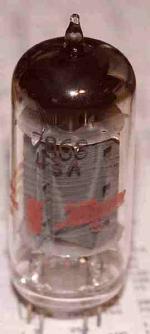
The main object of the project was to locate the weak point in the amplifier causing distortion and limited bandwidth.
This was NOT the output stage at all, it was the drivers.
Using a really horrible budget triode pentode but in the RIGHT way, to give very low distortion, wide bandwidth and extremely low noise, (the ECL series were always though of as really yuck hi distortion budget audio valves), to obtain a silken purse from a sow's ear, was the fun part.
- Status
- This old topic is closed. If you want to reopen this topic, contact a moderator using the "Report Post" button.
- Home
- Amplifiers
- Tubes / Valves
- Bogen beasts again
